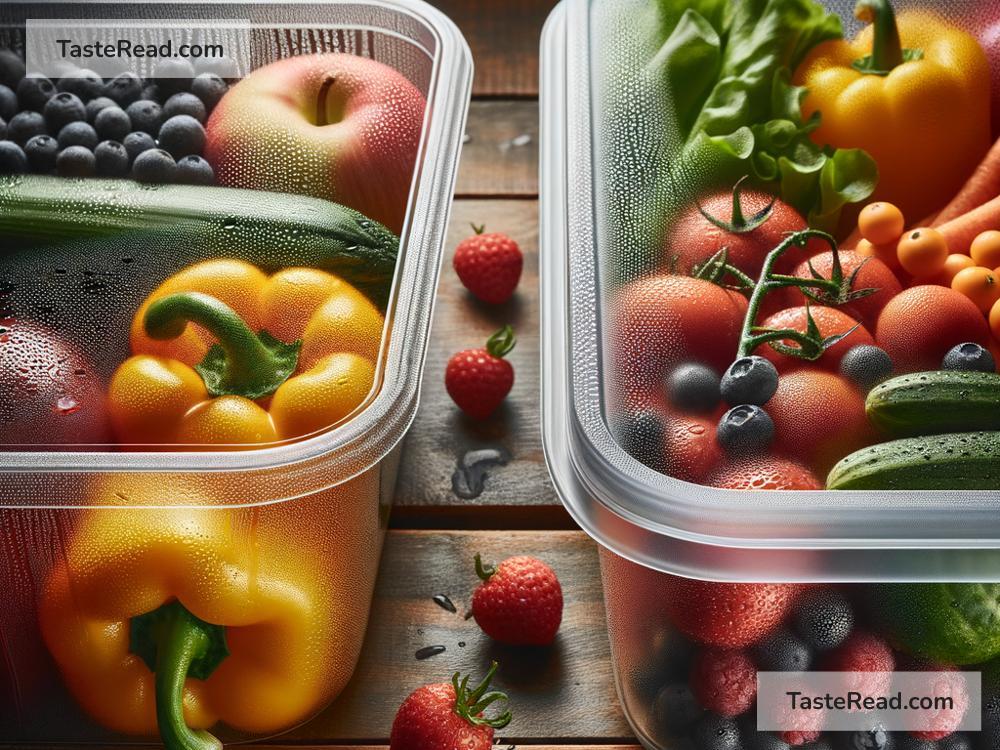Why Storage in Plastic Can Alter the Taste of Fresh Produce
We often rely on plastic containers and bags to store fresh produce, thinking it’s the best way to keep fruits and vegetables fresh. Plastic is lightweight, convenient, and affordable, so it’s no wonder it’s everywhere in our kitchens. But have you ever taken a bite of a fruit or vegetable after storing it in plastic, only to notice that the flavor seems slightly off? You’re not imagining things! Storing fresh produce in plastic can actually affect its taste. Here’s why this happens and what you can do to preserve the natural taste of your fruits and veggies.
The Science Behind Plastic and Produce
Plastic isn’t just a solid, lifeless material. It’s made up of different chemicals that are used to give it properties like flexibility, durability, and transparency. Some types of plastic, especially softer ones like cling film or thin storage bags, can interact with the food inside, even if you can’t see it happening.
When fresh produce is stored in plastic, chemical compounds from the plastic (such as certain additives or plasticizers) can leach into the food. This process is known as “leaching,” and it’s more common when food comes into direct contact with the plastic, especially if the food contains moisture, oils, or acid. While the amounts of chemicals transferred are usually very small and unlikely to harm your health in normal storage conditions, they can subtly alter the taste of the produce.
Some plastics are made with stronger barriers to prevent this kind of leakage, but not all plastic materials are created equal. If you notice an artificial or slightly odd taste in your produce after storing it in plastic, it could be because of these chemical exchanges.
Poor Air Circulation and Moisture Traps
Plastic storage containers typically form a tight seal, or plastic bags often trap moisture, which can create an environment where the flavor of fresh produce changes. Fruits and vegetables release gases and moisture as they age, even after being harvested. For example, apples release ethylene gas, which helps them ripen. When produce is stored in plastic, the gas and moisture can get trapped.
This lack of airflow and accumulated moisture can create a humid micro-environment that speeds up spoilage or affects taste. Leafy greens, for example, can take on a wilted or “plastic-y” taste when their natural moisture becomes trapped inside an airtight bag or poorly ventilated container.
On top of that, when produce sits in a plastic container where moisture is locked in, bacteria and mold can grow more quickly. While they might not be immediately visible, these microbes can affect the freshness and taste of your food.
Plastic Odors Can Stick
Another reason plastic alters the taste of fresh produce is its ability to absorb and retain odors. Have you ever noticed how a plastic container smells after holding strongly scented food like onions, garlic, or curry? It’s because plastic has a porous surface at a microscopic level, even if it looks smooth to the naked eye. As a result, it can absorb odors and transfer them to whatever you store next.
If you store fresh produce in a plastic container or bag that previously held another food with a strong smell, that scent can linger and seep into your fruits and veggies. Even new plastic items sometimes have a faint chemical smell that can affect the taste of your food.
How to Store Fresh Produce Without Altering the Taste
To keep your fruits and vegetables tasting fresh and delicious, consider switching up your storage methods. Here are a few tips:
-
Use Glass Containers
Glass containers are non-reactive, meaning they won’t leach any chemicals into your food or absorb odors. They’re also easy to clean and better for the environment. -
Try Reusable Cloth Bags or Paper Wraps
For produce like leafy greens and herbs, consider wrapping them in damp paper towels and storing them in cloth produce bags. These materials allow airflow while maintaining the right moisture levels. -
Stick with Perforated Containers
If you still prefer plastic for convenience, opt for perforated plastic containers or bags. These allow air to circulate and help prevent moisture buildup. -
Store Produce Separately
Avoid letting different types of produce touch each other in storage. Mixing fruits and vegetables can cause them to exchange gases, odors, or moisture that can impact their taste. -
Rinse Before Eating
If your produce has been stored in plastic, give it a quick rinse before eating. This helps wash away any lingering plastic residues or trapped moisture.
The Bigger Picture: Consider Sustainability
Plastic isn’t just bad for the taste of your food—it’s also bad for the environment. Millions of tons of plastic waste end up in landfills and oceans each year. Switching to eco-friendly storage alternatives, like glass, stainless steel, or washable cloth bags, can help reduce plastic waste and protect the planet.
Final Thoughts
Storing fresh produce in plastic is convenient, but it can sometimes alter the taste of your fruits and veggies. Whether due to chemical leaching, trapped moisture, or absorbed odors, plastic has a way of interfering with the natural flavors of our food. By exploring alternative storage methods like glass containers, cloth bags, or perforated containers, you can preserve the delicious, fresh taste of your produce and make a positive impact on the environment at the same time.
Fresh produce deserves to be enjoyed at its best—plastic-free!


